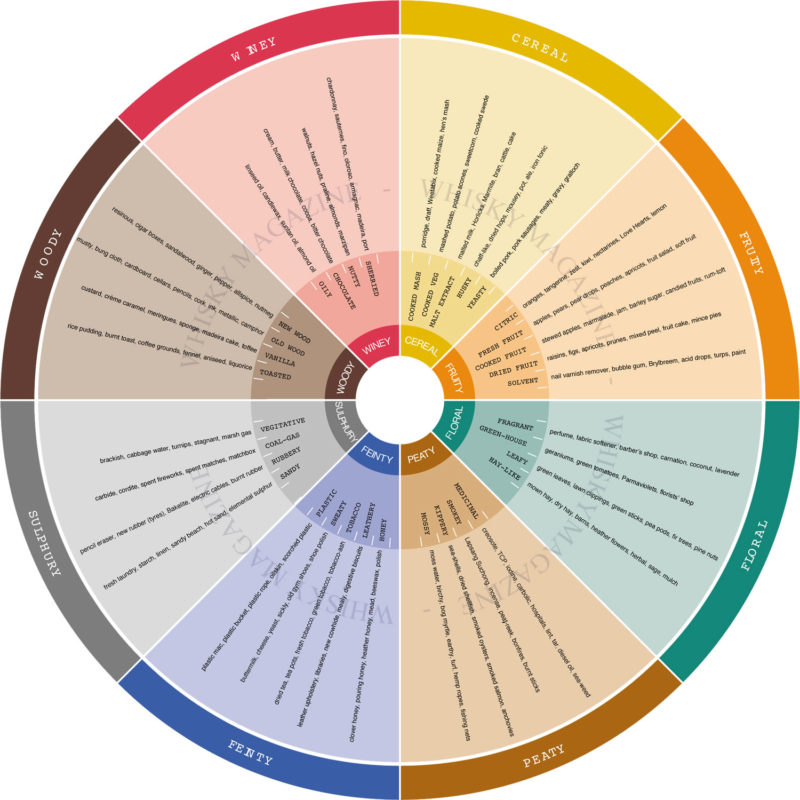How to use a whisky taste chart to improve your whisky tasting
Uncategorized
If you’ve ever wondered how to work on your whisky tasting from the comfort of your own home, then you’re in luck. This month, we take a look at a whisky taste chart that is going to help you tell your tobacco from your peat, or your medicinal from your pungent.
(If you’re new to whisky tasting and want to get up to speed before you check out the whisky taste chart, we’ve written a brief guide to the basics of whisky tasting.)
What is a whisky taste chart?
The idea of the whisky taste chart – sometimes known as the Whisky Flavour Wheel – was created by the Scotch Whisky Research Institute in the 1970s. In fact, it was Dr Jim Swan (remember him? He was the Einstein of Scotch that we wrote about a few months ago) and Sheila Burtles who devised the wheel, which continues to influence how people taste, judge and write about whisky.
However, the whisky taste chart we’re using today isn’t the one created by Dr Jim and Sheila Burtles, it’s Charles MacLean’s update of that concept. (For those who don’t know, Charles MacLean was described by The Times as ‘Scotland’s leading whisky expert’ and has been writing about whisky for 35 years, so you’re in safe hands.)
Why use a whisky taste chart?
Although you needn’t be able to describe a whisky accurately if you’re sipping a dram at home, professional tastings try to be as objective and accurate as possible. And, if you’re trying to up your whisky tasting game, here’s the place to start.
The taste chart gives you a model to work from and some industry language to use, so that everybody that tastes the whisky can describe it in the same way.
Or, as Charles MacLean says (he puts it far better than we can):
Many of the words we use to describe sensations are abstract – general concepts, rather than strictly objective descriptors. These are as legitimate as similes and metaphors, but they describe an overall impression – the whisky’s construction (to borrow a wine term), general style, character and quality – rather than specific aromas. As such they are useful. But they are not precise, and since they cannot be defined by reference to a standard, they are not strictly scientific.
Think of terms like ‘smooth’, ‘clean’, ‘fresh’, ‘coarse’, ‘heavy’, ‘light’, ‘rich’, ‘mellow’ or ‘young’. Some are relative terms: smooth compared to other malts, or perhaps other Speyside malts? Heavy for a Lowland malt?). Others have double meanings (soft can mean a suppression of alcohol and pungency, or it can mean gentle mouthfeel; young can mean immature or lithe and well-shaped). Many more are imprecise (rich can imply an intensity of character, or can mean rich as a fruit cake; fresh can mean acidic or vibrant). Such loose descriptors should be used with caution.
That’s where the whisky taste chart comes in – it lets even the most casual of whisky drinkers describe their whisky in scientific terms, just like the professionals.
So, without further ado, here is the wheel:

The idea is to begin at either the outside rim (if you can detect a vague aroma) or the inner rim (if you notice a core aroma) and then work to the other side of the circle, noticing different notes and flavours along the way.
And it works a charm. We gave it a go, and it really helps as a framework for detecting aromas and notes.
So why not grab your favourite dram and see if you can pick up a few flavours you might not have noticed before?
(And, if you’re really interested in the science of whisky tasting, be sure to check out this online course by Charles MacLean. You won’t regret it.)



